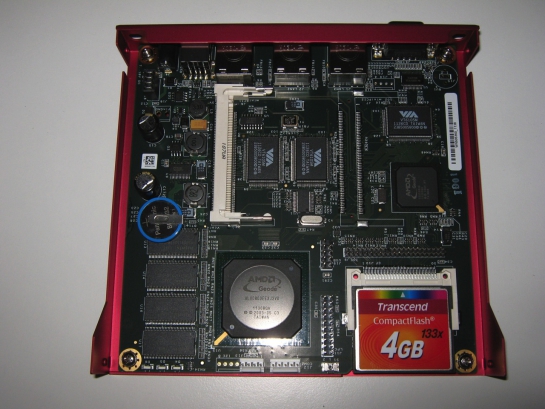
Autopsy:
After many years of use i have decided to replace my pfSense IPCop firewall installed on a Pentium III 500MHz / 512MB RAM with an embedded system like the “PC Engines Alix”.
The PC Engines ALIX series of system boards gives OEMs a higher performance replacement for the WRAP series of system boards.
Applications: Thin clients, kiosks, industrial user interface, wireless routers, firewalls, special purpose network devices…
source: varia-store.com
These are some of my old PC cards that i bought over the years and i have discovered in a box during the moving house.
Full List:
Intel 8/16 Lan Adapter (ISA)
Intel 8/16 Lan Adapter (ISA)
Genius Crystal Audio Card (ISA)
Terratec EWS 88D Audio Digital Card (PCI)
Creative Soundblaster SB16 Value (ISA)
Adaptec AHA 1510A SCSI (ISA)
Adaptec AHA 2940UW SCSI (PCI)
Adaptec AVA 1502E SCSI (ISA)
Joystick Card RTX 10E (ISA)
Matrox MGA 818_0101 Video Card (AGP)
Digicom ISDN Card (PCI)
Asus ISDN Card (PCI)
Asus ISDN Card (PCI)
Diamond 3DFX Rev A (PCI)
Diamond 3DFX Rev E (PCI)
Matrox MGA220P Video Card (PCI)
Parallel Card RTX 10D (ISA)
Unknown Winbond Lan Card BNC/RJ (ISA)
Unknown Winbond Lan Card BNC/RJ (PCI)
GeForce FX5200 Video Card (AGP)
Adaptec AVA 2904 SCSI (PCI)
Adaptec AVA 2904 SCSI (PCI) |
Matrox G4+ MMDHA32G (AGP)
Matrox G5+ MDHA16DLE (AGP)
S3 Trio 3D/2X Video Card (AGP)
Matrox MGA Mystique 220 Video Card (PCI)
Conexant Modem Card (PCI)
Radeon X300SE Video Card (PCIe)
Real Magic 64 Sigma Design Video Card (PCI)
Grandtec X Guard Video Surveillance Card (PCI)
Unknown Audio/Floppy Card (ISA)
Realtek Lan Card (PCI)
Compaq S3 Virge Video Card (ISA)
Innovision Multimedia ATA133 Raid Card (PCI)
ATI RV100 Video Card (AGP)
3COM 3C905TX Lan Card (PCI)
Asus V7100 Video Card (AGP)
ATI Rage XL Video Card (AGP)
GeForce FX5500 Video Card (AGP)
Matrox G55 Video Card (AGP)
Realtek RTL8180 Wireless Card (PCI)
Promise Ultra133 Controller (PCI) |
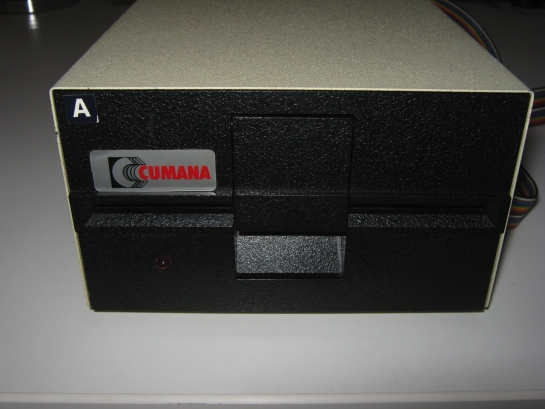
Autopsy:
Cumana is a low price hardware supplier for Apple, Amiga, Atari, Oric and so on. Here we present two examples of Floppy Drive compatible with the Apple II computers.
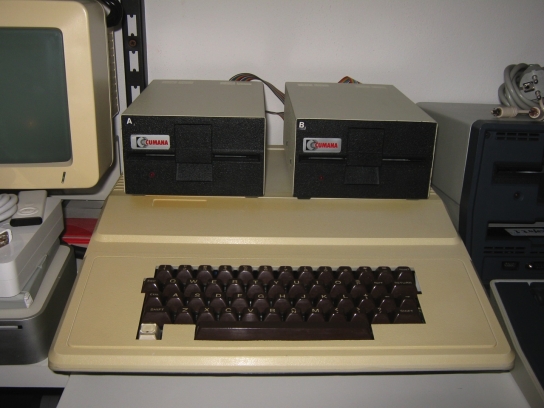
Autopsy:
This is a Apple II clone made by Computertechnik (SK-747 IBS Space 84) around late 70′s. This Apple computer resembles in all respects the original one.
from Wikipedia:
The Apple II is an 8-bit home computer, one of the first highly successful mass-produced microcomputer products, designed primarily by Steve Wozniak, manufactured by Apple Computer (now Apple Inc.) and introduced in 1977. It is the first model in a series of computers which were produced until Apple IIe production ceased in November 1993.
 The first Apple II computers went on sale on June 5, 1977 with a MOS Technology 6502 microprocessor running at 1 MHz, 4 kB of RAM, an audio cassette interface for loading programs and storing data, and the Integer BASIC programming language built into the ROMs. The video controller displayed 24 lines by 40 columns of monochrome, upper-case-only (the original character set matches ASCII characters 0×20 to 0x5F) text on the screen, with NTSC composite video output suitable for display on a TV monitor, or on a regular TV set by way of a separate RF modulator.
The first Apple II computers went on sale on June 5, 1977 with a MOS Technology 6502 microprocessor running at 1 MHz, 4 kB of RAM, an audio cassette interface for loading programs and storing data, and the Integer BASIC programming language built into the ROMs. The video controller displayed 24 lines by 40 columns of monochrome, upper-case-only (the original character set matches ASCII characters 0×20 to 0x5F) text on the screen, with NTSC composite video output suitable for display on a TV monitor, or on a regular TV set by way of a separate RF modulator.
The original retail price of the computer was 1298 USD (with 4 kB of RAM) and 2638 USD (with the maximum 48 kB of RAM). To reflect the computer’s color graphics capability, the Apple logo on the casing was represented using rainbow stripes, which remained a part of Apple’s corporate logo until early 1998. The earliest Apple II’s were assembled in Silicon Valley, and later in Texas; printed circuit boards were manufactured in Ireland and Singapore.
source: wikipedia
I have recovered a Osborn 1 in pretty nice cosmetic conditions but broken ;-(
List of broken stuff:
- Startup Garbage screen.
- Long startup beep.
- Reset works 1 times out of 20.
- Modem port desoldered.
- Powersupply ripple.
- Some screws missing.
Solutions & Fixes:
- Powersupply Ripples: Replaced some capacitors.
- Modem Port de-soldered: Fixed the cold solder.
- Startup garbage screen/long beep/reset: I have replaced a broken 4116 RAM.
- Screws missing: Replaced with a new one.
I have to thank Terry ‘Tezza’ of Classic Computers Blog for the piggyback ram guide.
I used an oscilloscope to find the faulty ram cause all ram in my motherboard seemed to work well. In the photo #9 you can see the signal of the pin 2 (data in) of a faulty ram, while in the photo #8 the same signal of a working a ram.

Autopsy:
from Wikipedia:
The Osborne 1 was the first commercially successful portable microcomputer, released on April 3, 1981 by Osborne Computer Corporation. It weighed 10.7 kg (23.5lb), cost USD$ 1795, and ran the then-popular CP/M 2.2 operating system. The computer shipped with a large bundle of software that was almost equivalent in value to the machine itself, a practice adopted by other CP/M computer vendors.
Its principal deficiencies were a tiny 5 inches (13 cm) display screen and use of single sided, single density floppy disk drives which could not contain sufficient data for practical business applications.
The Osborne’s design was based largely on the Xerox NoteTaker, a prototype developed at Xerox PARC in 1976 by Alan Kay. The Osborne 1 was developed by Adam Osborne and designed by Lee Felsenstein. It was first announced in April, 1981. Adam Osborne, an author of computer books, decided he wanted to break the price of computers.
The computer was designed to be portable, with a rugged ABS plastic case that closed up and a handle. The Osborne 1 was about the size and weight of a sewing machine and was advertised as the only computer that would fit underneath an airline seat. It is now classified as a “luggable” computer when compared to later laptop designs such as the Epson HX-20.
source: wikipedia
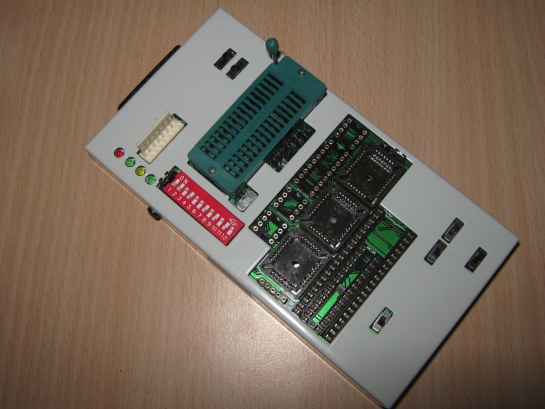
Autopsy:
After ten years of use, i finally decided to replace my old Willem programmer with an updated version of this nice programmer. The Willem PRO 4 ISP.
Willem PRO 4 ISP is the most popular programmer on Europe. Programmer is built on two-sided laminate with metal-plated openings, solder mask complete with description of components.
Willem PRO 4 ISP could be connected into devices directly via ISP (In System Programming) connector.The main advantage of ISP is possibility to program devices directly in place without any need to dismount them. Because of that and high-tech software solutions our programmer is much more useful in various programming tasks. ISP could be powered directly by Willem Programmer or by device’s power supply.
source: programatory.com

Autopsy:
Today i’m happy to present two new cartridges for the Commodore 64; Not Even Human (NEH) Inhuman Edition from Onslaught and Edge Grinder from Cosine.
Nowadays, i’m very pleased to see new cartridges for Commodore 64. Many years are gone but this computer doesn’t want to die and honestly i am very happy.
If you like to purchase these fantastic games go here.
source: rgcd.co.uk
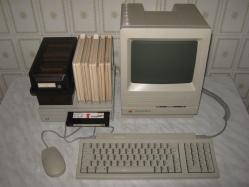
Autopsy:
The Macintosh SE/30 is a personal computer that was designed, manufactured and sold by Apple Computer, Inc. from 1989 until 1991. It was the fastest and most expandable of the original black-and-white compact Macintosh series.
The SE/30 is essentially a Macintosh IIx in the same case as the Macintosh SE, with a black-and-white monitor and a single PDS slot (rather than the NuBus slots of the IIx) which supported third-party accelerators, network cards, or a display adapter. Although officially only able to support 32 MB, the SE/30 could expand up to 128 MB of RAM (a ludicrous amount of RAM at the time), and included a 40 or 80 MB hard drive.
It was also the first compact Mac to include a 1.44 MB high density floppy disk drive as standard (late versions of the SE had one, but earlier versions did not). In keeping with Apple’s practice from the Apple II+ until the Power Macintosh G3 was announced, a logic board upgrade was available to convert a regular SE to a SE/30. The SE would then have exactly the same specs as an SE/30, with the difference only in the floppy drive if the SE had a 800k drive. The set included a new front bezel to replace the original SE bezel with that of an SE/30.
source: wikipedia
Macintosh SE/30 Fixing Motherboard Faults.
I spent many months (eight) to repair some of these macintosh SE/30 motherboard, like you can see in the gallery.
The flaws that i could find and repair are:
- Some multiplexers (74F253 or like) burned.
- Some Video Ram burned.
- Very Dirty Motherboard.
- Electrolytic capacitors have to be replaced.
- Reseat the RAM and ROM SIMM.
- Some track of the PCB broken or corroded by the acid.
- Replaced the lithium battery with a new one.
- Cold solder joint on chip: RP4/RP5/RP6 – UI2/UI3/UI4 – UJ2/UJ3/UJ4
The flaw that you see in the first picture and that should be the “Jail Bar Pattern” or “Smile Mac in Jail”, in this case is not been so. For this reason i spent a long time to find the fault.
However, i recovered 3 motherboards and I consider myself quite satisfied.
source: Repair Macintosh SE/30 68kmla.org #1 68kmla.org #2
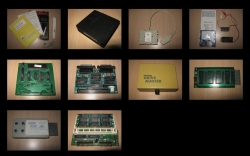
Autopsy:
Third Party Hardware for Atari ST.
Hardware Description (start from left to right):
- Brush Mouse by Golden Image.
- Steinberg Cubase Dongle.
- Auto Mouse-Joystick switch for Atari/Amiga.
- UhrModul Intern (Realtime Clock) by Hard & Soft.
- XT Expansion Interface.
- AdSCSI ST (SCSI Interface) by ICD.
- Drive Master by Pratical Solutions.
- ST Eprom Bank by Ilfa.
- Soundtrack Digital HQ Sound Sampler by ACN.
- Marpet MP210A 4Mb ram board.
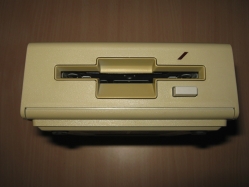
Autopsy:
This is a single-sided 3.5″ Floppy Drive for Atari ST series. This Floppy Drive can hold 360K of data on a disk.
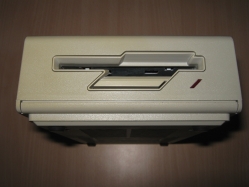
Autopsy:
This is a single-sided 3.5″ Floppy Drive for Atari ST series. This Floppy Drive can hold 360K of data on a disk.
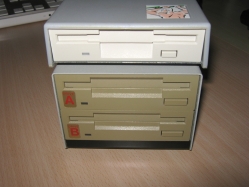
Autopsy:
Cumana & Power Computing are two hardware supplier for Amiga, Atari, Oric and so on. Here we present two examples of Floppy Drive compatible with the Atari ST series computers.
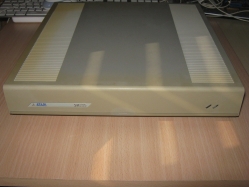
Autopsy:
The SH 205 also known as Atari Megafile 20 has a capacity of 20 MB and a ACSI interface. The Atari SH 205 uses an old 20 Mb 5.25″ MFM (Modified Frequency Modulation) Hard Drives Seagate or Tandon.







































 The first Apple II computers went on sale on June 5, 1977 with a MOS Technology 6502 microprocessor running at 1 MHz, 4 kB of RAM, an audio cassette interface for loading programs and storing data, and the Integer BASIC programming language built into the ROMs. The video controller displayed 24 lines by 40 columns of monochrome, upper-case-only (the original character set matches ASCII characters 0×20 to 0x5F) text on the screen, with NTSC composite video output suitable for display on a TV monitor, or on a regular TV set by way of a separate RF modulator.
The first Apple II computers went on sale on June 5, 1977 with a MOS Technology 6502 microprocessor running at 1 MHz, 4 kB of RAM, an audio cassette interface for loading programs and storing data, and the Integer BASIC programming language built into the ROMs. The video controller displayed 24 lines by 40 columns of monochrome, upper-case-only (the original character set matches ASCII characters 0×20 to 0x5F) text on the screen, with NTSC composite video output suitable for display on a TV monitor, or on a regular TV set by way of a separate RF modulator.

























































































































































Recent Comments